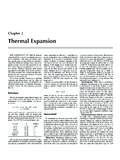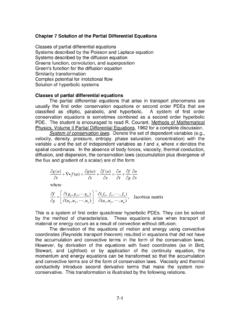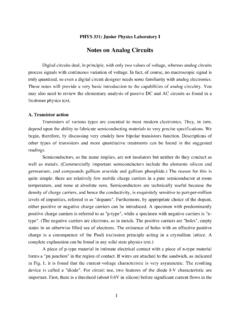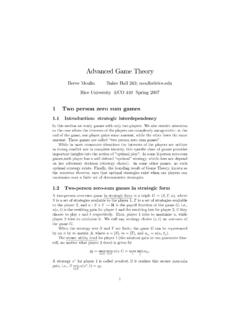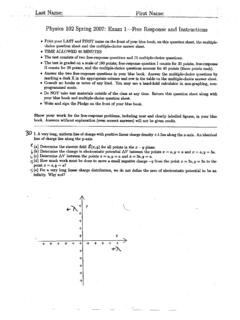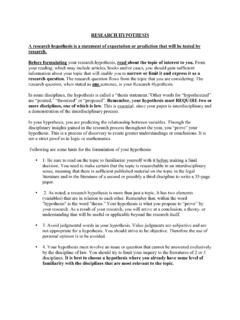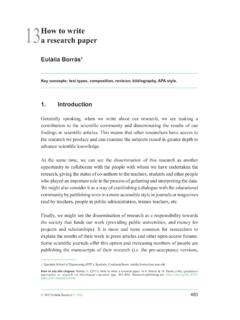Transcription of How to Read a Scientific Article - Rice University
1 1 How to read a Scientific ArticleMary Purugganan, Hewitt, Project in Engineering and Professional CommunicationReading a Scientific Article is a complex task. The worst way to approach this task is totreat it like the reading of a textbook reading from title to literature cited, digestingevery word along the way without any reflection or criticism. Rather, you should beginby skimming the Article to identify its structure and features. As you read , look for theauthor s main points. Generate questions before, during, and after reading. Drawinferences based on your own experiences and knowledge.
2 And to really improveunderstanding and recall, take notes as you read . This handout discusses each of thesestrategies in more Skim the Article and identify its journals use a conventional IMRD structure: An abstract followed by Introduction,Methods, Results, and Discussion. Each of these sections normally contains easilyrecognized conventional features, and if you read with an anticipation of these features,you will read an Article more quickly and comprehend of AbstractsAbstracts usually contain four kinds of information: purpose or rationale of study (why they did it) methodology (how they did it) results (what they found) conclusion (what it means)Most scientists read the abstract first.
3 Others especially experts in the field skip rightfrom the title to the visuals because the visuals, in many cases, tell the reader what kindsof experiments were done and what results were obtained. You should probably beginreading a paper by reading the abstract carefully and noting the four kinds of informationoutlined above. Then move first to the visuals and then to the rest of the of IntroductionsIntroductions serve two purposes: creating readers interest in the subject and providingthem with enough information to understand the Article . Generally, introductionsaccomplish this by leading readers from broad information (what is known about thetopic) to more specific information (what is not known) to a focal point (what questionthe authors asked and answered).
4 Thus, authors describe previous work that led tocurrent understanding of the topic (the broad) and then situate their work (the specific)within the of MethodsThe Methods section tells the reader what experiments were done to answer the questionstated in the Introduction. Methods are often difficult to read , especially for graduatestudents, because of technical language and a level of detail sufficient for another trainedscientist to repeat the experiments. However, you can more fully understand the designof the experiments and evaluate their validity by reading the Methods section of Results and DiscussionThe Results section contains results statements of what was found, and reference to thedata shown in visuals (figures and tables).
5 Normally, authors do not include informationthat would need to be referenced, such as comparison to others results. Instead, thatmaterial is placed in the Discussion placing the work in context of the broader Discussion also functions to provide a clear answer to the question posed in theIntroduction and to explain how the results support that StructureSome articles you read will deviate from the conventional content of IMRD sections. Forinstance, Letters to Nature appear to begin with an abstract, followed by the body of thearticle. Upon reading, however, you will see that the abstract is a summary of the workfilled with extensive introduction (for the purpose of catching the attention of a wideaudience), and the next paragraph begins a description of the , when you begin to read an Article for the first time, skim the Article to analyzethe document as a whole.
6 Are the sections labeled with headings that identify thestructure? If not, note what the structure is. Decide which sections contain the materialmost essential to your understanding of the Article . Then decide the order in which youwill read the Distinguish main articles contain so much information, it may be difficult to distinguish the mainpoints of an Article from the subordinate points. Fortunately, there are many indicators ofthe author s main points:Document level Title Abstract Keywords visuals (especially figure andtable titles) first sentence or the last 1-2sentences of the IntroductionParagraph level: words or phrases to look for surprising unexpected in contrast with previous work has seldom been addressed3 we hypothesize that we propose we introduce we develop the data suggest3.
7 Generate questions and be aware of your understandingReading is an active task. Before and during your reading, ask yourself these questions: Who are these authors? What journal is this? Might I question the credibility ofthe work? Have I taken the time to understand all the terminology? Have I gone back to read an Article or review that would help me understand thiswork better? Am I spending too much time reading the less important parts of this Article ? Is there someone I can talk to about confusing parts of this Article ?After reading, ask yourself these questions: What specific problem does this research address?
8 Why is it important? Is the method used a good one? The best one? What are the specific findings? Am I able to summarize them in one or twosentences? Are the findings supported by persuasive evidence? Is there an alternative interpretation of the data that the author did not address? How are the findings unique/new/unusual or supportive of other work in the field? How do these results relate to the work I m interested in? To other work I ve readabout? What are some of the specific applications of the ideas presented here? What aresome further experiments that would answer remaining questions?
9 4. Draw everything that you learn from an Article is stated explicitly. As you read , rely onyour prior knowledge and world experience, as well as the background provided in thearticle, to draw inferences from the material. Research has shown that readers whoactively draw inferences are better able to understand and recall an example, in the box below is an excerpt from the Introduction of an Article in thejournal Biochemistry (Ballestar et al., 2000). The comments in italics are questions andinferences that might be drawn by a student Syndrome is a childhood neurodevelopmental disorder and one of the most commoncauses of mental retardation in females Comment: be related to a gene onthe X-chromosome, with an incidence of 1 in 10000-15000.
10 Comment: How common isthat? Not too likely to happen to me, but there must be several such children born inHouston every year. Rett syndrome patients are characterized by a period of normalgrowth and development (6-18 months) followed by regression with loss of speech andpurposeful hand use. Comment: What happens? Something must be triggered oractivated at late infancy. Patients also develop seizures, autism, and ataxia. After initial4regression, the condition stabilizes and patients survive into adulthood. Studies offamilial cases provided evidence that Rett is caused by X-linked dominant mutations in agene subject to X-chromosome inactivation.
